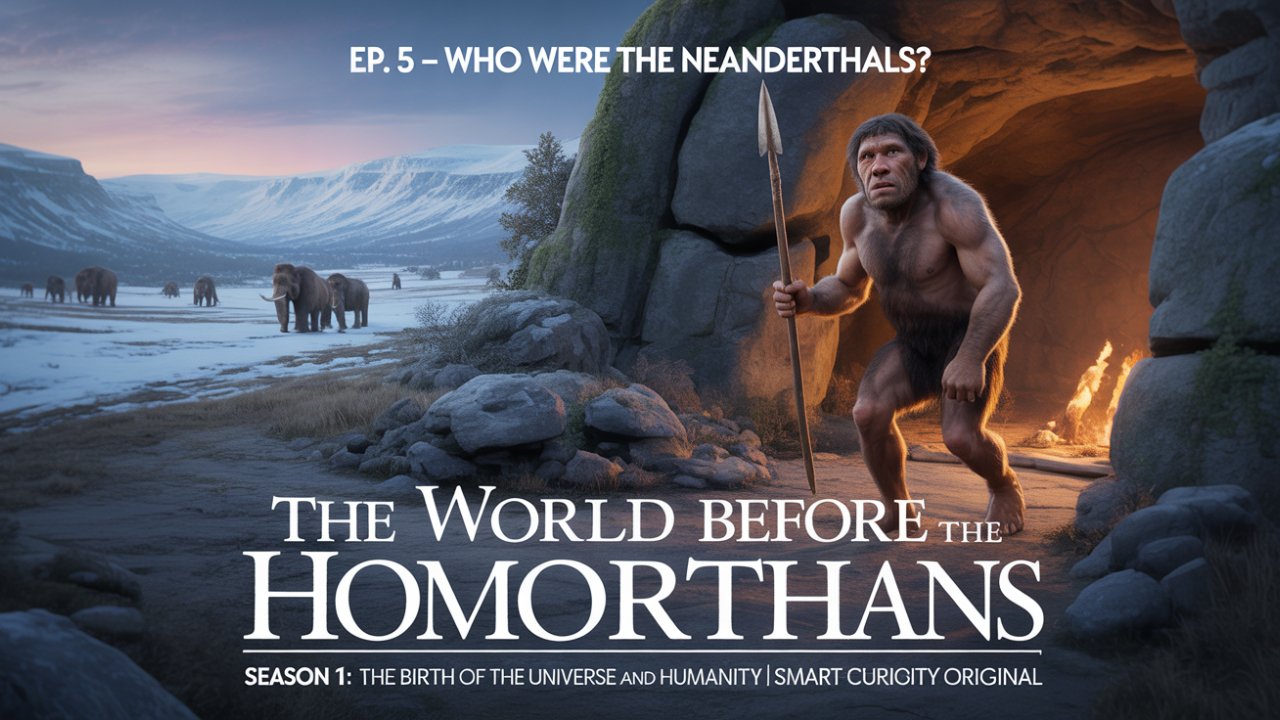Picture a world shrouded in ice, some 400,000 years ago. It’s a world not yet our own, but it’s home to a different kind of human. They’re shorter, stockier, and powerfully built to survive the biting cold. They’re skilled hunters, caring community members, and maybe even artists. They are the Neanderthals, a lost branch of our own family tree. For nearly 350,000 years, they were the dominant humans across Europe and Asia. But then, they vanished. What happened to them? And what can their story tell us about ourselves? Let’s take a journey back in time to meet the real Neanderthals.
The Discovery and the Myth
Our story doesn’t begin in the mists of the Ice Age, but in the summer of 1856, in Germany’s Neander Valley. That’s where quarry workers uncovered a strange set of bones: a thick skullcap with a heavy, sloping brow, and limb bones more robust than any they’d ever seen. At first, the remains were dismissed. One famous professor even claimed they belonged to a lost Russian Cossack from the Napoleonic wars, whose bowed legs came from a life on horseback and whose furrowed brow was from a lifetime of pain.
This was the world’s first introduction to a Neanderthal, and it set the stage for a century of misunderstandings. The timing was everything. Just three years later, Charles Darwin published “On the Origin of Species,” kicking off a firestorm of debate about evolution. In that climate, the idea of a primitive, ancient human was both fascinating and deeply threatening.
The popular image of the Neanderthal was truly cemented in 1908 by the French paleontologist Marcellin Boule. After studying a nearly complete skeleton from La Chapelle-aux-Saints, France, he unveiled his reconstruction: a stooped, hunched-over brute with a shuffling walk, a dullard who couldn’t even stand up straight. He saw a creature that was more ape than human, a failed evolutionary experiment. And just like that, the “brutish caveman” was born a club-wielding troglodyte who became the poster child for everything primitive and inferior. This caricature was powerful, persistent, and, as we now know, couldn’t have been more wrong.
For most of the 20th century, this was the view that stuck. Neanderthals were our dim-witted cousins, a sideshow in the grand story of Homo sapiens‘ inevitable rise. But science is a process of constant revision. As new fossils turned up and our tools for studying them got better, a very different picture began to emerge.
It turns out that skeleton from La Chapelle-aux-Saints belonged to an old man, one who was riddled with severe arthritis which explained his hunched posture. He wasn’t a typical Neanderthal; he was an elder who had lived a long life, likely because he was cared for by his group. Slowly, piece by piece, the old caricature started to fall apart, replaced by a picture of a human with remarkable complexity and resilience. The story of the Neanderthals wasn’t one of brutish failure, but of incredible survival in some of the harshest lands ever faced by humans. It’s a story that’s been rewritten by a wave of new research, revealing a lost chapter of humanity that’s far more compelling, and far more familiar, than we ever imagined.
A Lost Branch of the Human Family – Origins and Evolution
To find the roots of the Neanderthal family, we have to rewind the clock deep into the Ice Age, an era of dramatic climate swings that constantly reshaped the world. And our story doesn’t begin in Europe, but where all human stories do: in Africa. Around 600,000 years ago, a population of our likely shared ancestor, Homo heidelbergensis, started venturing out of the continent.
One group of these migrants pushed into Asia, eventually giving rise to another mysterious branch of the human family the Denisovans. Another group headed for Europe and Western Asia. It was this group that set the stage for the Neanderthals.
Separated from their African relatives by huge distances, these European pioneers began a long, slow transformation. Over thousands of generations, they adapted to the colder, tougher climates of Ice Age Eurasia. This wasn’t a single event, but a gradual process. Fossils from about 430,000 years ago, found in Spain’s Sima de los Huesos the “Pit of Bones” show early humans with distinctly Neanderthal-like faces, even while other parts of their bodies looked more ancient. These were the proto-Neanderthals.
Through a mix of natural selection driven by the cold and random genetic drift in their small, isolated groups, these unique features became more and more pronounced. By around 400,000 years ago, the humans we can definitively call Neanderthals had arrived. They were a uniquely Eurasian species, forged in the crucible of the Ice Age.
Modern genetics has opened an incredible new window into this deep past. By sequencing the Neanderthal genome, scientists can estimate when our evolutionary paths split. Current estimates suggest our common ancestor lived somewhere between 550,000 and 750,000 years ago. For a vast stretch of time, our lineages walked parallel paths ours in Africa, theirs in Eurasia. They aren’t our ancestors; they’re our closest extinct relatives, a sister species that grew up in a different part of the world. In fact, genetic data shows that Neanderthals and Denisovans are more closely related to each other than either is to us, painting a picture of a complex web of ancient humans.
For over 350,000 years, Neanderthals dominated a huge territory, from the shores of Portugal all the way to the Altai Mountains of Siberia. This was their world. They survived multiple ice ages, thriving in landscapes that would be almost unimaginable to us today. But they wouldn’t be alone forever. While they reigned in the north, a new kind of human was evolving back in Africa: a taller, more slender hominin with a differently shaped skull. Us. Homo sapiens. And our eventual meeting would change the course of human history forever.
Built for the Ice Age – Anatomy and Appearance
The Neanderthal body was a marvel of evolution, a form sculpted by the relentless pressures of a cold, unforgiving world. Calling them “primitive” misses the point entirely; they were different from us because they were perfectly evolved for a different world.
Let’s start with that iconic skull. It was long and low, not tall and rounded like ours, and it housed a brain that was, on average, slightly larger than the brain of a modern human. While brain size isn’t a direct measure of intelligence, it certainly throws out any idea that they were simple-minded. Their faces were striking, with a projecting mid-face, swept-back cheekbones, and a large, broad nose. For years, scientists figured this nose was a built-in radiator, meant to warm and humidify frigid Ice Age air. Below it was a powerful jaw that was missing something every one of us has: a bony, protruding chin. And towering over their eyes was that famous brow ridge, a double-arched bar of bone that probably helped buttress the skull against the stress of using their teeth as a third hand for gripping things.
Moving down, the Neanderthal physique was all about power and staying warm. They weren’t tall and lanky like the early Homo sapiens from Africa. They were compact and incredibly robust. Males stood around 5 feet 5 inches tall and weighed a muscular 165 pounds. Their bones were thicker and denser than ours, with markings that show where huge muscles were attached. A Neanderthal’s handshake would have been crushing.
Their bodies were built wider, with barrel-shaped chests and broad hips. Their limbs, especially their forearms and lower legs, were shorter. This is a classic example of adaptation to the cold a stockier build is far better at conserving body heat. This body wasn’t some crude first draft of a modern human. It was a highly specialized form, perfectly suited for a life of intense physical activity in a sub-arctic climate. Think powerlifter, not marathon runner. This physique is what allowed them to thrive in Pleistocene Eurasia for a stretch of time far longer than Homo sapiens has even existed.
A Day in the Life – Hunting, Diet, and Tools
So, what was it actually like to be a Neanderthal? Life was a constant dance with the environment, a cycle of hunting, gathering, and surviving in small, close-knit groups.
The foundation of their survival was their technology. Neanderthals are famous for the Mousterian stone tool industry, which was a huge leap forward. They perfected a clever technique that involved carefully preparing a stone core so they could strike off a perfect flake of a predetermined size and shape with a single, decisive blow. This required foresight, skill, and a deep understanding of their materials. These flakes were then turned into a versatile toolkit: sharp points for spears, scrapers for preparing animal hides, and knives for butchering meat. They were also masters of an ancient technology: making glue. They would heat birch bark in an oxygen-free environment to produce a sticky, waterproof pitch to glue stone points onto their spears a complex process that shows a high level of cognitive skill.
These tools were essential for hunting. And forget the old image of them as lowly scavengers. Isotope analysis of their bones shows they were at the very top of the food chain. They were skilled, cooperative hunters who took down the most formidable animals of the Ice Age: wild horses, bison, and even giants like the woolly rhinoceros and mammoth. Hunting these beasts was incredibly dangerous. Many Neanderthal skeletons show evidence of severe, traumatic injuries broken bones and crushed skulls that look remarkably similar to the injuries of modern-day rodeo riders. They were getting up close and personal with their prey, likely using their heavy spears for thrusting at close range.
But it wasn’t all meat. They were flexible omnivores. Fossilized plaque on their teeth has revealed starch granules from cooked plants, like grasses and tubers. They ate mushrooms, pine nuts, and moss. Along the coasts, they hunted seals and harvested shellfish. Their lives were lived in small groups, probably extended families, navigating a vast and empty landscape. Life was defined by skill, courage, and a deep, intimate connection to the world they called home.
More Human Than We Thought – Culture and Society
For more than a century, we assumed Neanderthals had no culture to speak of. They were seen as creatures of instinct, without the art, ritual, or symbolic thought that we believed made us special. But in the last few decades, a flood of new evidence has shattered that old caricature, revealing a rich and complex inner world. We now know their lives weren’t just about survival; they were about community, compassion, and maybe even a sense of beauty.
One of the most powerful clues to their humanity is how they treated their sick and elderly. Remember the “Old Man of La Chapelle,” the arthritic skeleton used to create the brutish stereotype? He couldn’t have survived for years in his condition without being fed and protected by his group. This wasn’t a one-off. At Shanidar Cave in Iraq, one individual survived for years with a crushed skull that would have blinded him in one eye, a withered arm, and a severe leg injury. He was cared for. This compassion, this social fabric of empathy and obligation, is a cornerstone of human culture.
Beyond caring for the living, there’s growing evidence that Neanderthals intentionally buried their dead. While there’s still debate about how complex these burials were, sites across their range show bodies carefully placed in pits. At Shanidar Cave, one burial famously contained pollen clumps, leading to the “flower burial” theory the idea that someone was laid to rest on a bed of flowers. Whether or not that specific interpretation holds up, the act of burial itself separates them from the animal kingdom. It suggests grief, respect, and maybe the first stirrings of spirituality.
And then there’s the question of art. For a long time, this was considered exclusive to Homo sapiens. Not anymore. At three different caves in Spain, red painted lines, dots, and a hand stencil have been dated to more than 65,000 years ago. That’s at least 20,000 years before modern humans are thought to have arrived in the area. The only people who could have made them were Neanderthals. In another cave in France, engravings on the wall what researchers call “finger-flutings” have been dated to at least 57,000 years ago. While we don’t know what these symbols meant, their existence proves that the capacity for abstract thought wasn’t unique to us.
Could they speak? While we’ll never hear their voices, their anatomy gives us tantalizing clues. A Neanderthal hyoid bone a small bone in the neck that’s crucial for speech is virtually identical to ours. Their ear bones show they were tuned to hear the same frequencies as modern human speech. While this doesn’t prove they had language as rich as ours, it shows they had the basic equipment. Their complex hunting strategies and social bonds would have been nearly impossible without some form of advanced vocal communication. The Neanderthal that emerges from this evidence is no longer a silent brute. They were thinking, feeling beings who cared for each other, mourned their dead,
When Worlds Collide – Neanderthals Meet Homo sapiens
While Neanderthals were ruling Eurasia, their distant cousins in Africa were evolving down a different path. Taller, leaner, and with a rounded skull and chin, Homo sapiens were built for a different world. For tens of thousands of years, our two species evolved in parallel, separated by geography. But eventually, our worlds were destined to collide.
Sometime around 50,000 to 60,000 years ago, waves of modern humans started moving out of Africa and into the Middle East the doorstep of the Neanderthal world. It was here that our ancestors came face-to-face with them for the first time.
So, what happened when they met? For a long time, the story was simple: we showed up, and they were wiped out. But the real story, written in the archaeological and genetic records, is far more interesting. It wasn’t a quick replacement; it was a long, complicated period of coexistence and interaction that lasted for thousands of years.
Sometimes, they were rivals. Homo sapiens brought with them a more diverse toolkit, with new technologies like the spear-thrower, or atlatl, which let them hunt more safely from a distance. We also seem to have lived in larger, more interconnected groups, which would have been a huge advantage during tough times.
But they didn’t just compete. They connected. And we have absolute proof of this written in our own DNA. The 2010 sequencing of the Neanderthal genome dropped a bombshell: almost everyone today of non-African descent carries between 1% and 2% Neanderthal DNA. This is the unmistakable signature of ancient encounters. It means that for thousands of years, our two species lived side-by-side, competed, and, on at least some occasions, had children together. This genetic exchange was a critical chapter in our own story, and we carried those genetic gifts with us as we spread across the rest of the world. For several millennia, the planet was home to multiple intelligent human species. But this world wasn’t meant to last. As Homo sapiens continued to expand, the world of the Neanderthals began to shrink, setting the stage for one of the greatest mysteries in human prehistory.
The Great Disappearance – Why Did They Vanish?
For over 350,000 years, they mastered Eurasia and survived countless ice ages. And then, in what is just a blink of an eye in geologic time, they were gone. The last Neanderthals vanished around 40,000 years ago. So why did they disappear? This is the ultimate Neanderthal question, and there’s no single, easy answer. Their extinction was likely a perfect storm of converging factors.
One of the prime suspects is climate change. The late Ice Age was a time of wild and rapid climate swings. These shifts would have dramatically altered the landscapes and disrupted the animal herds Neanderthals depended on. While they were expert survivors of climate change, these particular fluctuations were unusually severe.
It was into this volatile world that a new competitor arrived: us. Our ancestors likely had a few key advantages. While Neanderthals lived in small, scattered groups, modern humans formed larger social networks. If one group was struggling, they could turn to their allies for help. Technologically, our toolkit was more diverse. And innovations like the spear-thrower may have given us a crucial edge.
Then there’s the demographic problem. The total Neanderthal population was always small, perhaps only a few thousand individuals spread across their vast territory. These small, isolated groups would have been vulnerable to inbreeding and a loss of genetic diversity. The arrival of Homo sapiens might have made this worse. If small Neanderthal groups were regularly being absorbed into much larger modern human populations through interbreeding, it could have slowly drained their numbers away, leading to an extinction by assimilation.
A final theory is disease. Modern humans migrating from Africa may have brought pathogens that the Neanderthal immune system had never encountered and had no defense against, much like what happened when Europeans arrived in the Americas. While there’s no direct proof, a wave of new diseases could have been devastating.
Ultimately, it was probably not just one of these things, but a fatal combination of them all. Small, scattered populations, already stressed by a chaotic climate, were faced with a new, more numerous, and highly adaptable human species. They didn’t vanish overnight. They faded away, retreating into final refuges in places like Gibraltar, until at last, the last of them disappeared, leaving Homo sapiens as the last humans standing.
The story of the Neanderthals is constantly evolving, challenging everything we thought we knew about the human story. If you found this journey into our deep past as fascinating as we do, please subscribe for more explorations into the mysteries of history and science.
The Ghost in Our Genes – The Neanderthal Legacy
The disappearance of the Neanderthals wasn’t truly the end of their story. In a very real sense, they are still with us. Their legacy lives on, not in stone tools, but in the biological code of billions of people alive today. Anyone with ancestry outside of Africa walks the Earth carrying a small but meaningful piece of the Neanderthal genome a direct inheritance from those encounters in the Ice Age.
This genetic legacy has real effects. Some Neanderthal genes helped our ancestors adapt, boosting our immune systems to fight off new viruses. They affect our skin and hair. But it’s a mixed bag. Other Neanderthal genes are linked to an increased risk for things like type 2 diabetes or certain autoimmune diseases. They weren’t “good” or “bad” genes; they were just adaptations for a Neanderthal’s life, now operating in the very different world of our modern bodies.
Beyond the genetic echo, the greatest legacy of the Neanderthals is how they’ve forced us to redefine what it means to be human. For so long, we saw evolution as a straight line of progress, with us at the top. Neanderthals shattered that idea. They show us the past was a much more interesting place, a world with a branching bush of different humanities, a time when we were not alone.
They were not a failed experiment or a brutish caricature. They were a successful and intelligent species that thrived for hundreds of thousands of years. Their story is a powerful reminder of how fragile existence can be, and a testament to the deep, complex, and interwoven history of the entire human family. They are our closest extinct relatives, our forgotten kin, and their ghost in our genes walks with us still.





